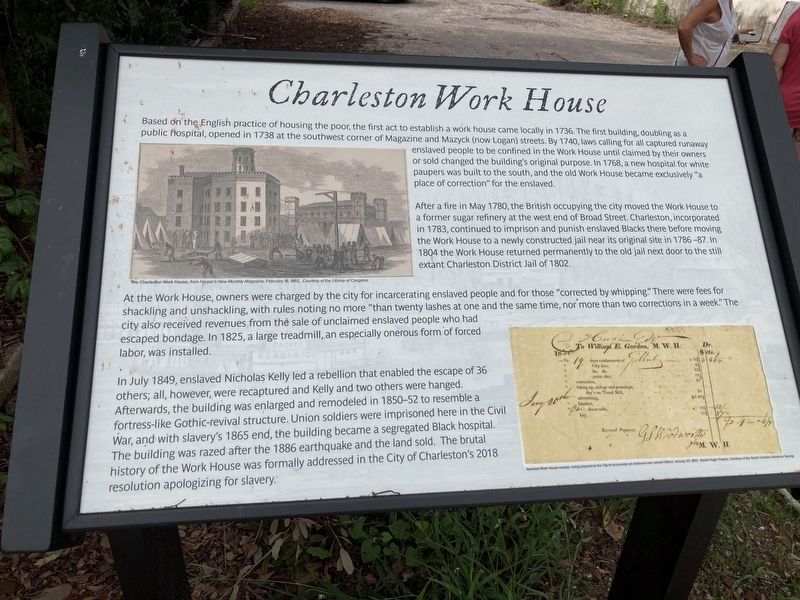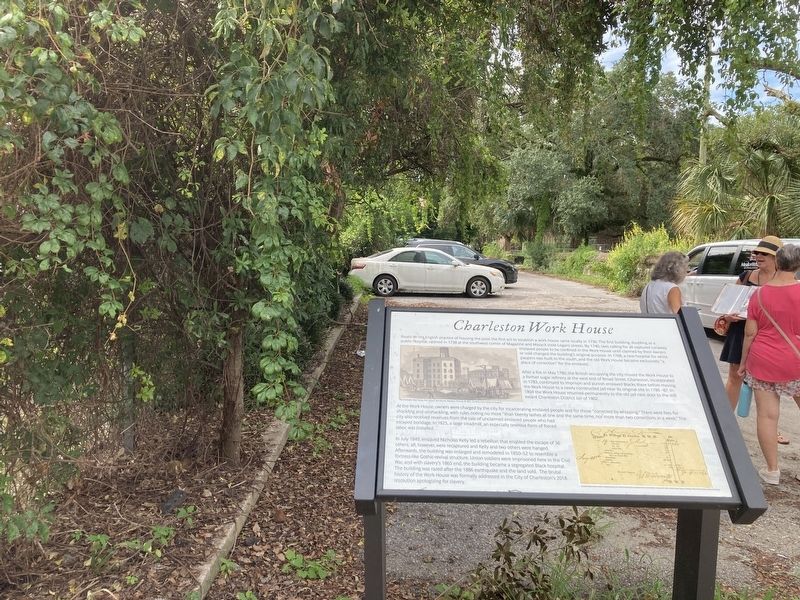Harleston Village in Charleston in Charleston County, South Carolina — The American South (South Atlantic)
Charleston Work House
After a fire in May 1780, the British occupying the city moved the Work House to a former sugar refinery at the west end of Broad Street. Charleston, incorporated in 1783, continued to imprison and punish enslaved Blacks there before moving the Work House to a newly constructed jail near its original site in 1786-87. In 1804 the Work House returned permanently to the old jail next door to the still extant Charleston District Jail of 1802.
At the Work House, owners were charged by the city for incarcerating enslaved people and for those "corrected by whipping." There were fees for shackling and unshackling, with rules noting no more "than twenty lashes at one and the same time, nor more than two corrections in a week." The city also received revenues from the sale of unclaimed enslaved people who had escaped bondatge. In 1825, a large treadmill, an especially onerous form of forced labor, was installed.
In July 1849, enslaved Nicholas Kelly led a rebellion that enabled the escape of 36 others; all, however, were recaptured and Kelly and two others were hanged. Afterwards, the building was enlarged and remodeled in 1850-52 to resemble a fortress-like Gothic revival structure. Union soldiers were imprisoned here in the Civil War, and with slavery's 1865 end, the building became a segregated Black hospital. The building was razed after the 1886 earthquake and the land sold. The brutal history of the Work House was formally addressed in the City of Charleston's 2018 resolution apologizing for slavery.
(captions)
The Charleston Work House, from Harper's New Monthly Magazine, Frbruary 18, 1865. Courtesy of the Library of Congress.
Itemized Work House receipt, noting payment to the City to incarcerate an enslved man named Gilbert, January 20, 1830. Daniel Huger Papers, Courtesy of the South Carolina Historical Society.
Erected 2022 by City of Charleston.
Topics. This historical marker is listed in these topic lists: African Americans • Colonial Era • War, US Civil. A significant historical year for this entry is 1736.
Location. 32° 46.72′ N, 79° 56.209′ W. Marker is in Charleston, South Carolina, in Charleston County. It is in Harleston Village. Marker is on Magazine Street west of Logan Street, on the left when traveling west. Touch for map. Marker is at or near this postal address: 21 Magazine St, Charleston SC 29401, United States of America. Touch for directions.
Other nearby markers. At least 8 other markers are within walking distance of this marker. Fielding Home for Funerals (about 300 feet away, measured in a direct line); Old Marine Hospital (about 300 feet away); Jenkins Orphanage (about 300 feet away); United States Marine Hospital (about 400 feet away); First Medical College of South Carolina Site (about 500 feet away); Philip Porcher House (about 600 feet away); St. John's Church (about 700 feet away); Pollitzer House (about 700 feet away). Touch for a list and map of all markers in Charleston.
Credits. This page was last revised on February 16, 2023. It was originally submitted on September 12, 2022. This page has been viewed 562 times since then and 192 times this year. Photos: 1, 2. submitted on September 12, 2022. • Bernard Fisher was the editor who published this page.

